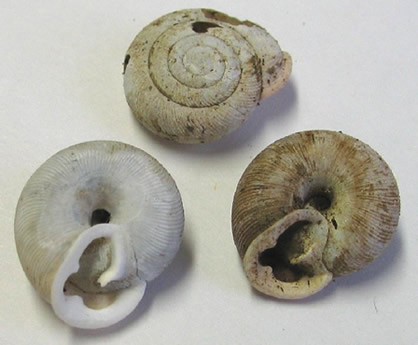Pennsylvania Land Snails

Photo(s): Brent Steury
Triodopsis juxtidens (Pilsbry, 1894)
Common name: Atlantic threetooth
Family Polygyridae
Order Stylommatophora
The Atlantic threetooth is one of a bewildering array of three-“toothed” snails from the central Appalachian Mountains, with five representatives in Pennsylvania! However, these animals are not as difficult to determine as you might think.
The Atlantic threetooth has a flattened shell—from 12 to 19mm diameter (Pilsbry, 1940)—an open umbilicus and strong ribs. The shell aperture has the classic reflected lip and three denticles or “teeth."
Only two of the five Keystone State threetooth snails are widespread—the Atlantic threetooth and the northern threetooth (Triodopsis tridentata)—and these two have lip teeth that are small and peg like. The three restricted species (Triodopsis fraudulenta, T. picea, and T. vulgata) each have at least one large lip tooth that is not peg like.
Of the two common species, the Atlantic threetooth generally lives in the eastern part of Pennsylvania and its congener is to the west. The parietal lamella of the Atlantic threetooth points at or above the upper of the two denticles on the lip, whereas it points between the lip teeth {or below the outer lip tooth} for the northern threetooth.
In Pennsylvania forests the Atlantic threetooth is scattered in leaf litter and finds cover near rocks or sticks, but it also occurs in a wide variety of other habitats, even in urban vacant lots (Hubricht, 1985). It reaches higher densities in richer soils. Old shells in the litter typically appear white, having lost their brown protein coat, or periostracum.
In Pennsylvania the Atlantic threetooth is commonly found on the east side of the Appalachian Mountains, in the Valley-and-Ridge, near New Jersey and around the Delaware Bay. It has been reported to the western side of the Keystone State (e.g. Hubricht, 1985), but because it can be confused with the northern threetooth, these reports need further investigation.
Profile by:
Ken Hotopp, 4/25/06
 Development of this site was supported by the generous contributions of Pennsylvanians to the Wild Resource Conservation Fund.
Development of this site was supported by the generous contributions of Pennsylvanians to the Wild Resource Conservation Fund.
